-
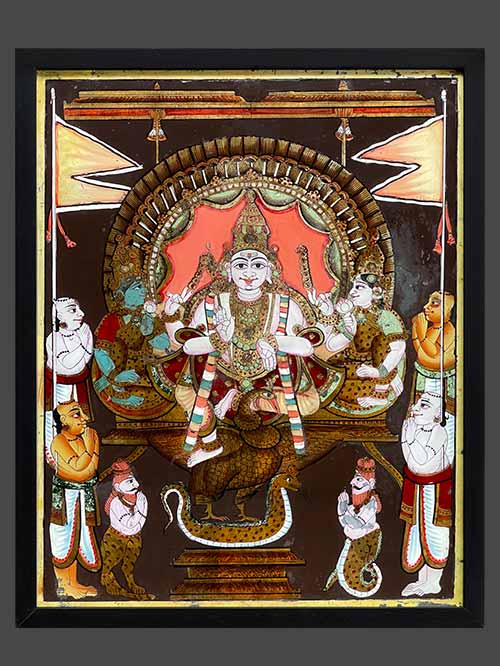
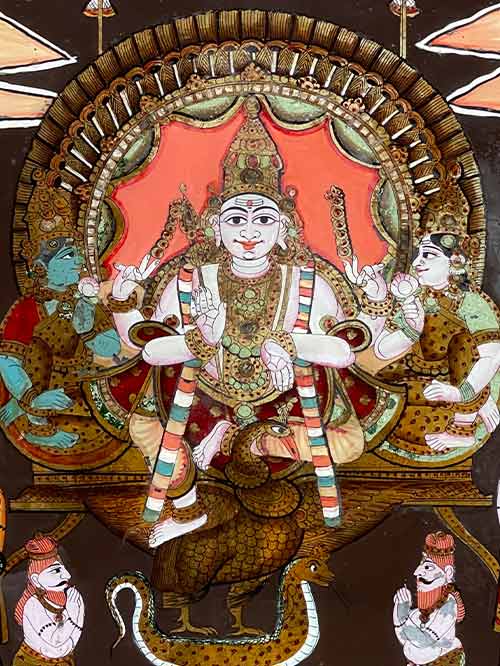
Tanjore (South India)
reverse painting on glass
Kartikeya (also known as Subrahmanyam, Murugan or Skanda) sits on a throne held up by his conveyance, the peacock. His consorts, the fair Devasena on his left and the blue-complexioned Valli on his right, are seated by his side. The realistically rendered tail of the peacock frames the trio and doubles as a ritual prabhavali. The peacock stands majestically with its talons firmly planted on a cobra. Set against a brown background, flags define the sides of the painting where four Brahmin devotees pay homage to the divine group along with the sages Patanjali on the right and Vyaghrapada on the left.
Reverse glass paintings were introduced into India the late 18th century from China by way of the China Trade. Indian artists adopted the technique of reverse glass painting partly on account of its novelty and also because it was a relatively inexpensive medium which could produce rich effects. The technique proved extremely popular and soon spread through western and southern India and even to former provincial Mughal capitals of Oudh, Murshidabad.
In Tanjore – a small state with an old art tradition- a distinctive school of glass painting developed in the early 19th century and continued for more than a hundred years. The style was essential Indian – it tended to repeat patterns of regional painting: images of deities, portraits and themes form the ancient myths, secular themes such as portraits of kings or nobles, courtesans and musicians. The colour was rich and the style bold and defiant. The subjects were clearly presented with a certain opulence and glamour.
Painting Size (cms): 50(H) x 40(W)
Painting Size (inches): 19.75(H) x 15.75(W)
Framed Size (cms): 54(H) x 44(W) x 4(D)
Framed Size (inches): 21.5(H) x 17.5(W) x 1.5(D)
-
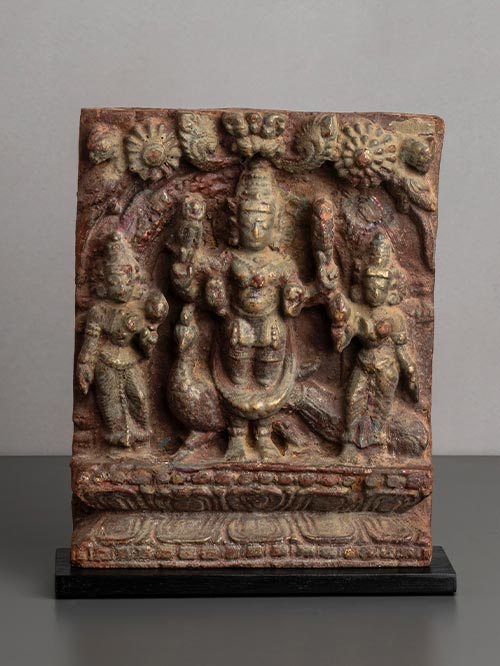
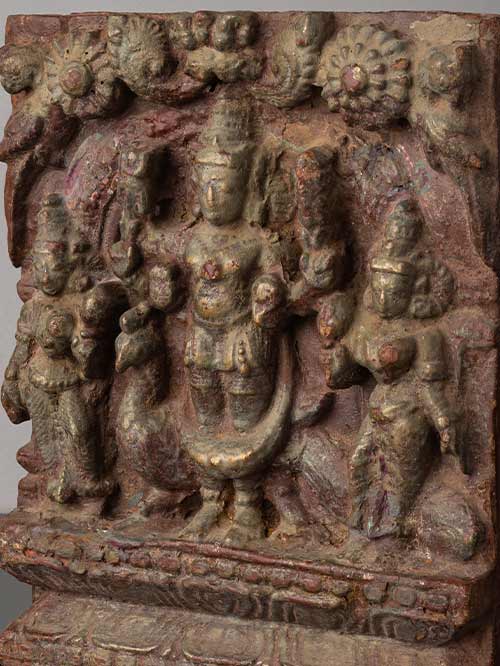
Tamil Nadu
Wood with traces of polychroming
A decorative, small chariot panel depicting Kartikeya (also known as Subrahmanyam, Murugan or Skanda). His consorts Devasena and Valli stand on either side and his peacock vahana stands by his feet. A prabhavali topped by a kirtimukha (face of glory) surrounds the deity.
Karttikeya is the god of war and ruler of the planet Mars. Generally thought of as the son of Shiva and Parvati. He is shown riding or standing near his peacock, a symbol of immortality, carrying various weapons, such as a club, battle-axe and chisel, and his typical weapon, the spear.
Chariots of Tamil Nadu, locally called ter, are intricate wooden structures of monumental size. The lower portion of the chariots are completely covered with timber panels carved with a wide range of figural and animal sculptures. These friezes, which constitute the finest wooden sculptures in the region, can be viewed only during the chariot festival; for the remainder of the year the chariots are parked in shelters to protect them from the sun and rain.
Size (cms): 29(H) x 34(W) x 8.5(D)
Size (inches): 11.5(H) x 13.5(W) x 3.5(D)
-
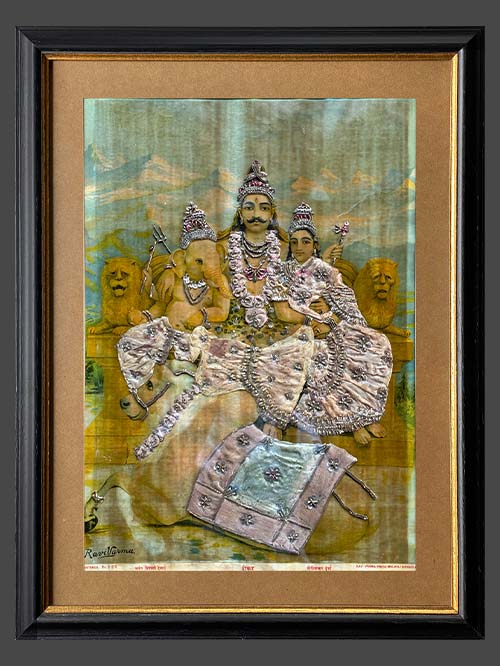
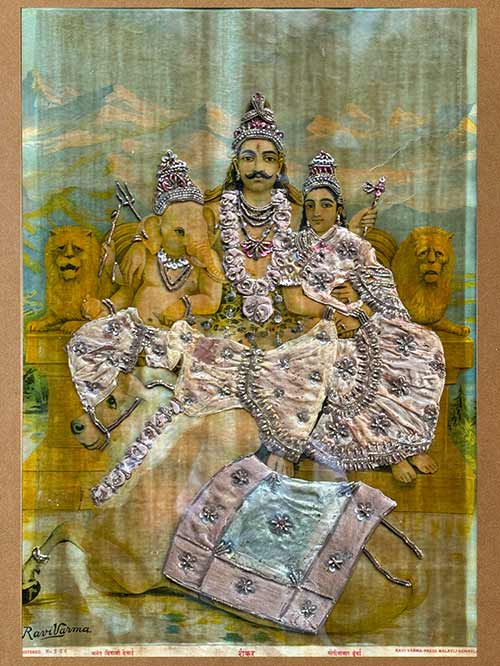
Published at the Ravi Varma Press, Malavli, Lonavla
by Raja Ravi Varma
chromolithograph with fabric appliqué
Shiva, Parvati & Ganesha are seated on a lion throne with Shiva’s caparisoned vahana Nandin seated under them. Shiva is known as the “destroyer and the transformer.” His wife Parvati, is the Hindu goddess of fertility, love and devotion; as well as of divine strength and power. Ganesha is widely revered as the remover of obstacles, the patron of arts and sciences and the deva of intellect and wisdom.
Ravi Varma occupies an important place in Indian art history. He developed a painting style that appropriated the illusionary techniques of European oil painting with traditional Indian subject matter. The popularity of Ravi Varma’s paintings gave him the idea to make oleographs that would be available to the general public, instead of only elite patrons. Oleographs, also called chromolithographs, are multi-colour art prints, stemming from the process of lithography.
These immensely popular chromolithographs from the Ravi Varma press quickly set a new iconographical standard for the traditional Indian heroes and deities. Often the figures were embellished with embroidered sequins and other decorative material, creating vibrant pulsating images.
Image Size (cms): 49.5 (H) x 34.5 (W)
Image Size (inches): 19.5 (H) x 13.6 (W)
Framed Size (cms): 62 (H) x 48.5 (W)
Framed Size (inches): 24.5 (H) x 19 (W)
-
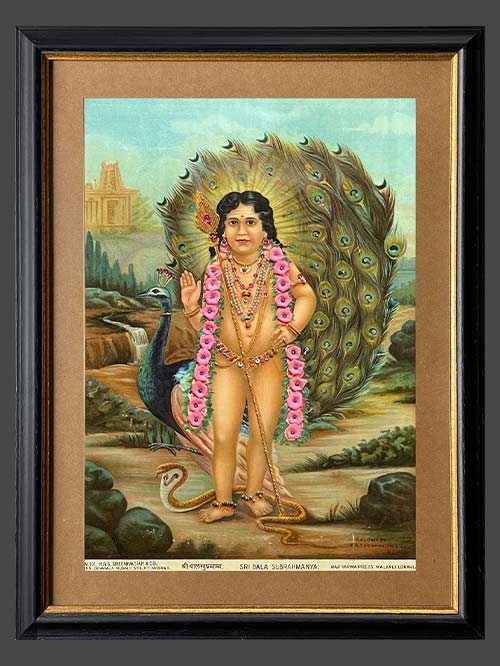
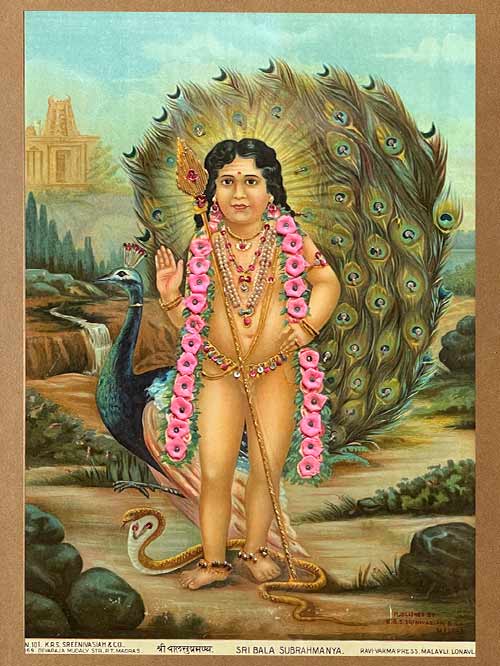
Published at the Ravi Varma Press, Malavli, Lonavla
chromolithograph with fabric appliqué
Subrahmanyam (also known as Kartikeya, Murugan or Skanda) stands next to his conveyance, a majestic peacock with its spotted train of feathers on full display. Subrahmanyam, naked but for his sumptuous jewellery stands with one arm raised in Abaya mudra (fear not gesture) while the other is firmly planted on his hip. A golden cobra rests behind his feet. Subhramanyam is generally thought of as the son of Shiva and Parvati.
Oleographs, also called chromolithographs, are multi-colour art prints, stemming from the process of lithography. These immensely popular oleographs from the Ravi Varma press quickly set a new iconographical standard for the traditional Indian heroes and deities. Often the figures were embellished with embroidered sequins and other decorative material, creating vibrant pulsating images. After Ravi Varma was forced to sell the press along with the reproduction rights in 1901, the press began producing work by other contemporaries of Ravi Varma including C.G. Ramanujam, producing equally vibrant work with new themes and subjects. The influence of the oleographs from this press is still felt strongly in modern Indian popular art forms such as calendar art.
Image Size (cms): 49.5 (H) x 34.5 (W)
Image Size (inches): 19.5 (H) x 13.6 (W)
Framed Size (cms): 62 (H) x 48.5 (W)
Framed Size (inches): 24.5 (H) x 19 (W)
-
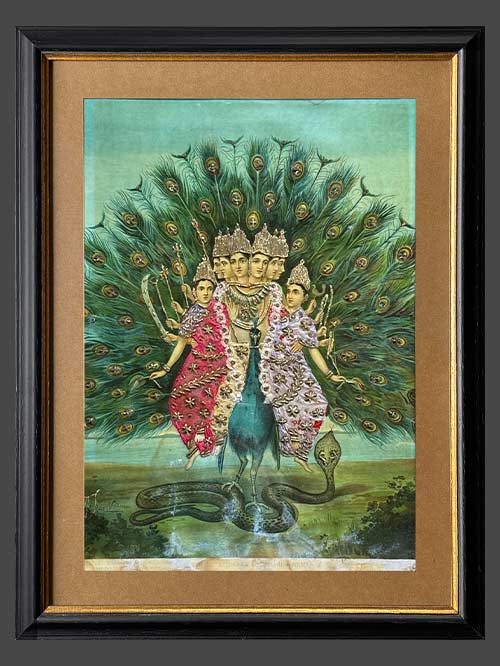

Published at the Ravi Varma Press, Malavli, Lonavla
chromolithograph with fabric appliqué
Subrahmanyam (also known as Kartikeya, Murugan or Skanda) stands next to his conveyance, a majestic peacock with its spotted train of feathers on full display. Subrahmanyam, naked but for his sumptuous jewellery stands with one arm raised in Abaya mudra (fear not gesture) while the other is firmly planted on his hip. A golden cobra rests behind his feet. Subhramanyam is generally thought of as the son of Shiva and Parvati.
Ravi Varma occupies an important place in Indian art history. He developed a painting style that appropriated the illusionary techniques of European oil painting with traditional Indian subject matter. The popularity of Ravi Varma’s paintings gave him the idea to make oleographs that would be available to the general public, instead of only elite patrons. Oleographs, also called chromolithographs, are multi-colour art prints, stemming from the process of lithography.
These immensely popular chromolithographs from the Ravi Varma press quickly set a new iconographical standard for the traditional Indian heroes and deities. Often the figures were embellished with embroidered sequins and other decorative material, creating vibrant pulsating images.
Image Size (cms): 49.5 (H) x 34.5 (W)
Image Size (inches): 19.5 (H) x 13.6 (W)
Framed Size (cms): 62 (H) x 48.5 (W)
Framed Size (inches): 24.5 (H) x 19 (W)











